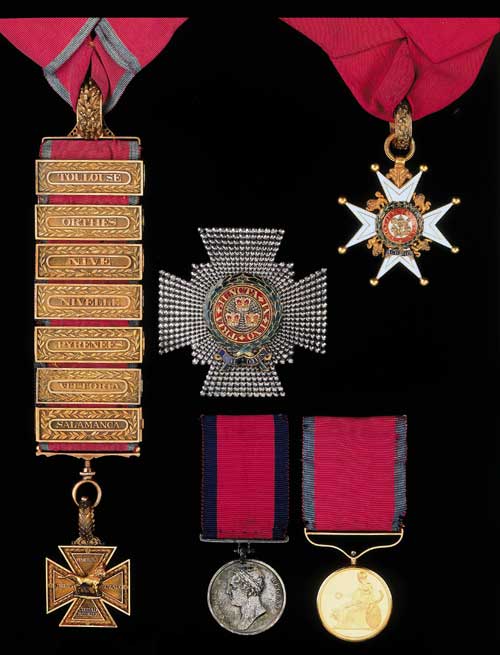
Auction: 3016 - Orders, Medals, Decorations & Militaria
Lot: 481
The Important Seven Clasp Army Gold Cross Group to Major-General Sir Denis Pack K.C.B., Brigade Commander, Wounded Eight Times, Thanked by Parliament Five Times for his Military Services
(a) Order of the Bath, Knight Commander's (K.C.B.) set of insignia, Military Division, neck Badge, 60mm., by James Edwards, London, gold and enamel (Hallmarks for London 1814 and maker's mark JE), with original large gold ring suspension and original wide gold riband fitment, some chipping to white enamel and green wreath; Star, 85.5mm., silver, gold and enamel, a scarce sew-on type by Hamlet, London, the reverse inscribed 'Hamlet Jeweller to their Royal Highnesses the Princesses Augusta, Elizabeth, Mary and Sophia, Princes Street Leicester Square London', minor enamel damage
(b) Army Gold Cross for Vimieira, Corunna, Buzaco and Ciudad Rodrigo (Br. General Denis Pack), lacking gold lion from reverse, with seven clasps, Salamanca, Vittoria, Pyrenees, Nivelle, Nive, Orthes, Toulouse, with original gold swivel-ring suspension, gold suspension ring, top gold riband clasp and neck riband gold fitment
(c) Field Officer's Small Army Gold Medal, the reverse inscribed Roleia, Vimiera, & Corunna 1808.9. (Lieut. Col: Denis Pack, 71st. Foot.)
(d) Waterloo Medal (Major-General Sir Denis Pack, K.C.B.), with contemporary steel clip and later bar suspension, contact wear, very fine, except where stated the group good very fine (5)
Major-General Sir Denis Pack, K.C.B. (c.1772-1823), was the son of Thomas Pack, Dean of Ballinakill, Queen's County, Ireland, later Dean of Ossory and subsequently Dean of Kilkenny. He was gazetted a Cornet in the 14th Light Dragoons in November 1791, and in 1794, after a period of service which involved him in the quelling of civil disturbance in Ireland, went with a Squadron of his Regiment to Flanders. As a young officer in the Duke of York's army he participated in several minor actions during 1794-5, the most significant of which was the engagement at Boxtel and in the harsh winder retreat to Bremen. Early in 1795 Pack returned home and in March obtained his Lieutenancy, and commanded an 80-strong detachment of Dragoons in the Quiberon expedition and did duty as a field officer on the Isle Dieu. Back in England in February 1796, Pack was given a troop in the 5th Dragoon Guards and proceeded with his Regiment to Ireland where he was mainly occupied with the rebellion and with the French 'invasion' in 1798. Upon the capture of the French Generals he commanded the escort directed to convey them to Dublin. In August Pack was promoted to Major in the 4th Royal Irish Dragoons and for the next two years remained stationed in England and Scotland, obtaining on 6 Dec. 1800 appointment as Lieutenant-Colonel of the 71st Highlanders, whereupon he joined this Regiment in Ireland and remained there until 1805.
SOUTH AFRICA
In 1805 he embarked with his Regiment in Sir David Baird's expedition to recapture the Cape of Good Hope and despite being wounded at the landing at Lospard's Bay, continued in the field and the following day commanded at the Battle of Blueberg.
SOUTH AFRICA
At the beginning of 1806 Pack joined the expedition to South America under the command of General Beresford where he was present at various actions, was wounded again, and taken prisoner, but was able to make his escape to Monte Video. He was then placed in command of all the Light Companies in General Whitelocke's army, commanding in the disastrous attack on Buenos Ayres, and subsequently in two successful actions during which he was three times wounded. He returned to Europe at the end of 1807 and early in 1808 embarked with the 71st at Cork as part of Sir Arthur Wellesley's expedition to Portugal where in August he commanded at the battles of Roleia and Vimiera, and in January 1809 at the battle of Corunna. He was afterwards given a command in the Walcheren expedition, and following the siege of Flushing was warmly commended by General Sir Eyre Coote for his gallant contribution to the town's surrender. He became aide-de-camp to the King with the rank of Colonel (25th July 1810) and commanded a Portuguese brigade under Marshal Beresford at Busaco, 1810, and at Almeida, May 1811. At the latter action, Pack pursued the fleeing French garrison as far as Barba del Puerco, finally to return to blow up the defences of Almeida. Pack was once again in action with his Portuguese brigade at the capture of Ciudad Rodrigo. Now ranked as a British Brigadier-General, he was sent to make a false attack on the outwork of the Santiago gate. This action, however was to be converted into a real attack. He distinguished himself at the battle of Salamanca, and was honourably mentioned for his services at Burgos.
Pack was made a Major-General, 4th June 1813. He once again led his brigade at Vittoria and whilst in temporary command of the 6th Division in the Pyrenees, was wounded at Sauroren. He commanded a Division at Nivelle, the Nive, Orthez, and Toulouse, where he was wounded and honourably mentioned.
After his Peninsular services he was offered a brigade in the expedition to America, but instead was appointed to command at Ramsgate. Pack's last foreign service was to be in command of a brigade of Picton's Division at Quatre Bras and Waterloo, where he was again wounded.
He was appointed Colonel of the York Chasseurs in 1816, Lieutenant-Governor of Plymouth 12th August 1819., and Colonel 84th Foot 9th September 1822. He died 24th July 1823 and some five years later his wife erected a monument to him in Kilkenny Cathedral, where his father had been Dean.
Subject to 20% VAT on Buyer’s Premium. For more information please view Terms and Conditions for Buyers.
Sold for
£100,000




